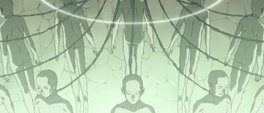Texhnolyze
Bringing back the creative forces behind the 1998 series Serial Experiments Lain came Texhnolyze in 2003: a thoroughly peculiar name and the decade's best example of mind-bending anime. Scenario creator Chikai J. Konaka was riding high after 'Lain and the well received Hellsing TV series, around the same time Texhnolyze was released he had already lent his hand to the RahXephon movie (Pluralitas Concentio) and would go on to do the Air Gear TV series as well as Masamune Shirow's Ghost Hound. Character designer Yoshitoshi ABe meanwhile had leant his hand to a number of series previously including Haibane Renmei and Nie Under 7, however this would remain his last character work for anime for the foreseeable future.
The setting could not be more verdant for exploration: an underground society - the only place on earth where the component for artificial limbs can be harvested - carved up by ceaseless gang fighting. The company-sponsored Organo tussle with the anti-prosthetic Union while in the middle is a religious sect who worship prognosticators born only once in a generation. Ichise, a bare-knuckle brawler, is mutilated by his employer and only saved after being taken in by an arrogant and capricious doctor, eager to experiment. He is fitted with the latest prosthetic limbs, texhnolyzed in the series' parlance, and eventually joins the Organo in their ongoing fight. However those who control the city, the Class, begin to move and the streets of the decaying city, Lux, become a warzone.
Serial Experiments Lain stood for a long time as the definitive mindfuck: disjointed and exceptionally strange it was a landmark for non-traditional storytelling and toyed with ideas far ahead of its time; it took Texhnolyze, a little watched series, to overtake Lain when it came to a subversive narrative style but trumped it when it came to poise and ceaseless quality throughout. Helmed by Madhouse studios, the animation and visual quality is superb; even with such a muted colour palette the depth of detail in the characters and the backdrops construct a superbly wintry and subdued atmosphere so befitting of the subject matter.
Ichise's ascension from an unknown streetfighter to preferential colleague of Organo's head, Onishi, is juxtaposed against that of humanity as a whole. Lux is portrayed as a city of downtrodden proletariats - all ragged clothing and and matted hair - so it is at first odd that the violent interloper, Yoshii, speaks of how alive Lux is. His provocation of a gang war between the Union, Organo and the volatile Racan is stopped swiftly enough but his is only the first salvo as the Class invades the city with perverse abominations known only as "Shapes". Ichise ventures to the lush technicolor heaven of the surface only to find the occupants are ghosts, impassive and stuck in an evolutionary dead end. When he returns to the hell of Lux, it is to find only carnage as the last living remnants slaughter each other.
Analysing the series in any depth threatens to overwhelm, the layers of symbolism and hidden meanings are immense, straddling both future science and spiritualism. Onishi for instance can supposedly hear the voice of the city as if it were a living thing, the people of Gabe meanwhile worship their prophet as a deity, even the city Lux turns from a dreary purgatory into a grey hell in contrast to the aloof surface world. Evolution is a favoured theme in Texhnolyze much as it was in 'Lain, the idea that the prosthetic limbs represent a next stage of evolution for humans is a preferred topic for the Doctor to soliloquise on, despite knowing the outcome of the surface dwellers. Kanno, the final antagonist of the series and progenitor of the almost wholly texhnolyzed Shapes, goes further saying that the grotesque Shapes are the next evolutionary step, even when they cease functioning and take root around the city. These are only the most prominent of themes and any amount of exploration will be met with a cornucopia of examinations on topics as diverse as the beauty in deformity, the nature of a hierarchy within an organisation and the callousness of those with power.
Texhnolyze stands as one of the bleakest and most untraditionally told series of the decade; it submerges the audience into a cold and unfriendly world rife with duplicity and violence, that it is more vibrant and alive than the ephemeral world above it is a sombre realisation. It is a meditative look at the effect machines have on humanity when all barriers between them are removed and just how far a person and a society is willing to go in their pursuit of knowledge and when backed into a corner. Very few other series manage to hold such a melancholy and oppressive atmosphere throughout and while at times challenging to watch, it is sublimely intelligent and enchanting to interpret.
Miscellanea
The trailer for Texhnolyze uses a remixed track from the Serial Experiments Lain Cyberia Mix soundtrack: Antidepressant 044.
The opening is GUARDIAN ANGEL by Juno Reactor who also performed a lot of the Matrix sequel's soundtrack. The Japanese release of the Texhnolyze soundtrack contained only the TV length version of the song while the American release by Geneon contained the full length version.
Vitals
First aired: 17 April 2003
Finished airing: 25 September 2003
Episodes: 22
Availability: DVD - Amazon.com, Amazon.co.uk, United Publications (UK)
References: MyAnimeList, Wikipedia, AniDB, Fan site







